Introduction
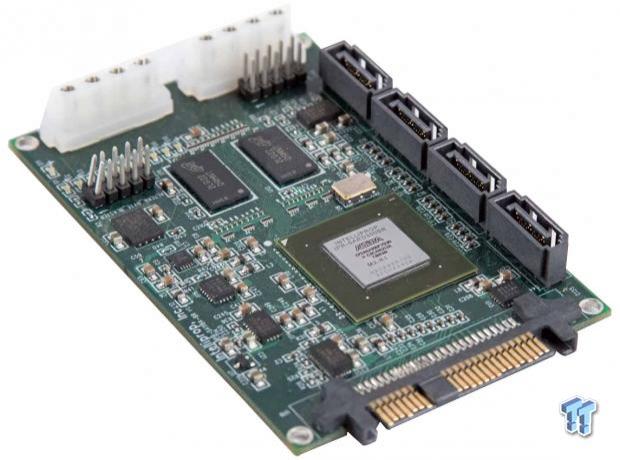
The face of the datacenter is changing, and radical new approaches are emerging that provide more options for high-performance storage solutions. The size of the server rack has been shrinking quickly, and multi-node units are becoming more commonplace. These dense compute solutions require incredible storage density and performance, while maintaining a heavy workload resilience. The HYDRA Bridge solution from IntelliProp steps in, enabling companies to produce solutions to address this challenging segment.
IntelliProp is a name many will not be familiar with; as a component manufacturer, they do not bask in the limelight often. Intelliprop is a Colorado-based hardware engineering company that has provided ASIC design and verification services for the storage industry since 1998. They also supply storage IP cores for SATA, SAS, PCIe, RAID, cores, and bridge solutions. IntelliProp has extensive knowledge and experience with all major storage protocols (ATA, Serial ATA, SCSI, Serial Attached SCSI, Fibre Channel, CompactFlash+, MMC, and CE-ATA). While not obvious to all, IntelliProp products power many storage devices currently on the market.
The SATA 3.0 HYDRA Bridge onboard our reference sample is the star of the show. The HYDRA features IntelliProp's internally developed SATA interface cores and logic. The design provides a means for manufacturers to combine the performance and capacity of multiple (two or four) SSDs into one cohesive unit. The HYDRA bridges the SSDs and presents them as one volume to the host system.
This allows for devices in the 2.5" and 3.5" form factor that can pack an astounding amount of performance and capacity. With the maximum density of a 2.5" 15K HDD at 900GB, the ability to cram up to 4TB of storage into the same 2.5" slot is impressive.
SSDs quickly fall into steady state under extended workloads, but aggregating several SSDs into one unit provides a higher performance ceiling. The HYDRA stripes data across the devices to keep performance high, even under the most brutal workloads. The aggregated performance of multiple drives moves the bottleneck to the SATA 6Gb/s connection.
Stellar read/write performance is important, but an added benefit of these aggregated volumes is the enhanced endurance of the device. Internally spreading the write workload among multiple SSDs mitigates the wear on each SSD. This allows for a stunning amount of write endurance from a single device, and can facilitate the use of lower-endurance NAND in heavy write workloads.
Even low-capacity versions of HYDRA enabled products are compelling; they can provide much more performance and endurance than any single SSD on the market. Several industry partners, such as Avant, are already designing and producing products with an integrated HYDRA controller. Avant demonstrated a working sample of an enterprise-class SSD featuring the HYDRA controller during LSI's AIS event, proving the technology is mature and market-ready.
Our reference board will allow us to test the HYDRA with four regular SSDs. In a finished product, the drive components will be placed onto smaller PCB's. These PCB's will house the required traces and routing needed to allow the device to function in concert with multiple SSD controllers.
One of the great features of the HYDRA Bridge is ease of deployment, there is no requirement for special drivers or software, and the drives are simply plug and play. Our reference board allows us to connect and test four SATA SSDs to demonstrate the performance of the HYDRA Bridge solution. First, let's take a closer look at the capabilities of the HYDRA platform.
HYDRA Architecture
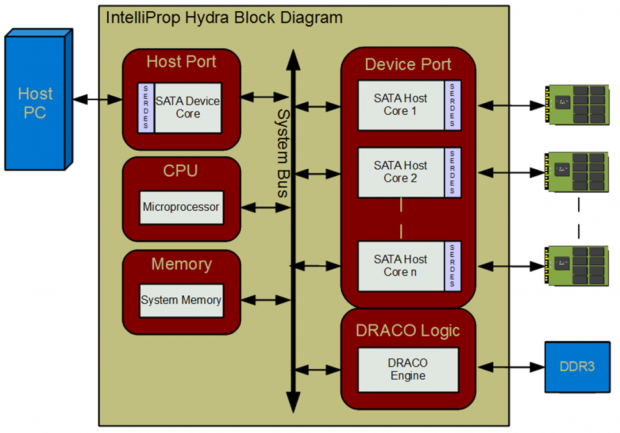
The HYDRA IPA-SA117A-BR aggregates two or four storage devices into one cohesive unit with NCQ capabilities. The design requires no firmware intervention for read/write I/Os. The bridge introduces minimal latency, which is imperative in SSD applications. The controller features support for SMART monitoring, and also issues TRIM and vendor-specific commands. The architecture also supports cascading for larger deployments of 60+ devices.
The HYDRA Bridge design is divided into four blocks: the SATA host cores, the SATA device core, the DRACO data engine, and the processor and memory. The IntelliProp SATA core provides the SATA interface, and the IntelliProp SATA Device core manages the PC connection. If needed, speed bridging can present 1.5 and 3Gb/s drives as 6Gb/s drives to the host PC. No additional software or drivers are required for the host machine.
The DRACO engine consists of an LBA translator, a data router, and the DRACO State Machine. The LBA translator tracks incoming requests and maps them to the correct LBA's. There is also an ATA Host State Machine and a DATA FIFO for each drive connection.
The controller merely interfaces with existing SSD designs. Support for the myriad of other technologies, such as power capacitors and ECC, is handled by the underlying units. HYDRA also supports integration of external DDR3 to facilitate device functions.
HYDRA stripes data on the underlying SSDs with a stripe size that targets the page size of the flash, to ensure consistent operations. HYDRA supports DIPM/HIPM power modes, and the design is tolerant of temperatures from -40C to +100C, which is necessary in high heat server environments. We test power consumption later in the evaluation.

HYDRA Reference Board
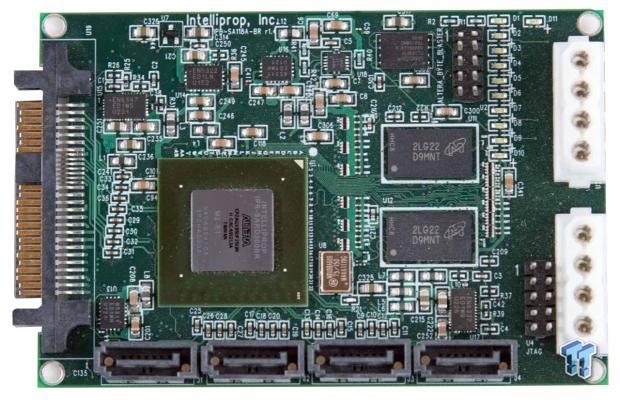
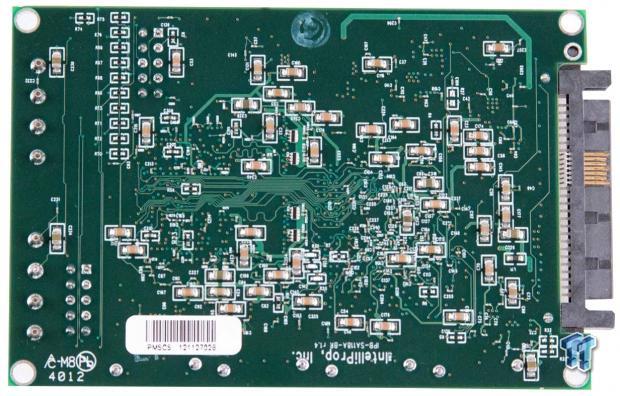
Our HYDRA SATA Bridge reference board came with a SAS-to-SATA cable for connection of the board to a standard SATA port. Devices featuring the IPA-SA117A-BR utilize a SATA 6Gb/s connection in actual deployment.
We note the two Micron 1Gb DDR3-1333 DRAM cache modules to the right of the controller. Four SATA connectors line the bottom of the PCB, and two Molex connections are available to supply power on the right edge.
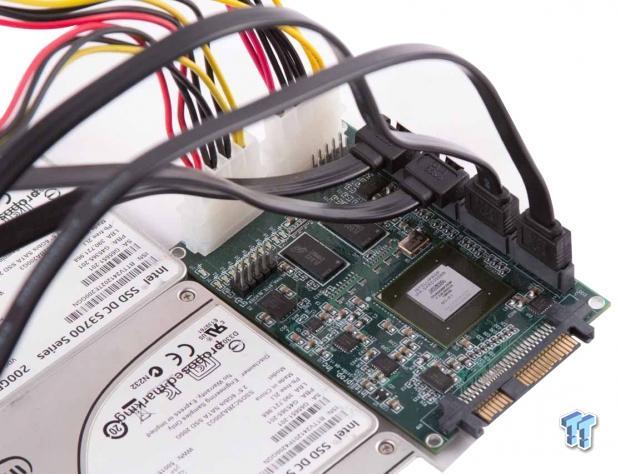
For testing, we connected four 200GB Intel DC S3700 SSDs to the HYDRA Bridge.

At LSI's AIS 2013 event, we spied a working prototype of a HYDRA device in Avant's booth. Avant manufactures SSD solutions under their own name, as well as for other manufacturers. It is possible that we could see this same device branded through several different companies. This 2TB device has four separate SSD controllers working in concert with the HYDRA solution in a 2.5" SSD with a 15mm z-height.

We observe the plethora of power capacitors on the top of this custom three-PCB SSD.

The three PCBs are densely stacked to provide copious capacity in a slim device.
Test System and Methodology


Our Enterprise Test Bench is specifically designed to target long-term performance with a high level of granularity. Many testing methods record peak and average measurements during the test period. These average values give a basic understanding of performance, but fall short in providing the clearest view possible of I/O QoS (Quality of Service).
Average results do little to indicate performance variability experienced during actual deployment. The degree of variability is especially pertinent, as many applications can hang or lag as they wait for I/O requests to complete. This testing methodology illustrates performance variability, and includes average measurements, during the measurement window.
While under load, all storage solutions deliver variable levels of performance. While this fluctuation is normal, the degree of variability is what separates enterprise storage solutions from typical client-side hardware. Providing ongoing measurements from our workloads with one-second reporting intervals illustrates product differentiation in relation to I/O QOS. Scatter charts give readers a basic understanding of I/O latency distribution, without directly observing numerous graphs.
Consistent latency is the goal of every storage solution, and measurements like Maximum Latency only illuminate the single longest I/O received during testing. This can be misleading, as a single 'outlying I/O' can skew the view of an otherwise superb solution. Standard Deviation measurements consider latency distribution, but do not always effectively illustrate I/O distribution with enough granularity to provide a clear picture of system performance. We use histograms to illuminate the latency of every I/O issued during our test runs.
Our testing regimen follows SNIA principles to ensure consistent, repeatable testing. We measure power consumption during precondition runs. This provides measurements in time-based fashion, with results for every second, to illuminate the behavior of power consumption in steady state conditions. Power consumption can cost more over the life of the device than the initial acquisition price of the hardware itself, significantly affecting the TCO of the storage solution.
We connected four Intel DC S3700 200GB SSDs to the HYDRA Bridge for our tests, and higher maximum speeds may be possible with other hardware. The first page of results will provide the 'key' to understanding and interpreting our test methodology.
4K Random Read/Write
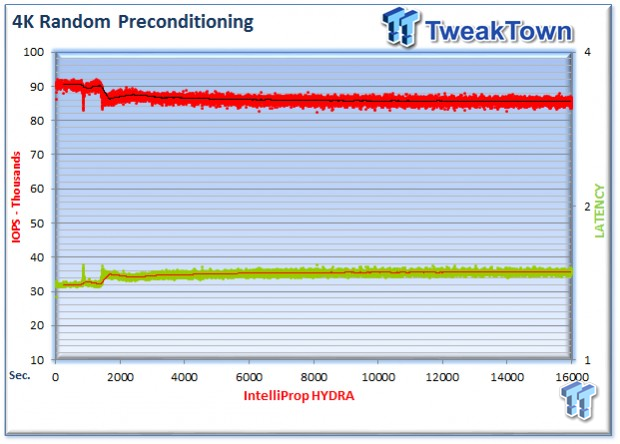
We precondition the HYDRA Bridge with 4 x 200GB Intel DC S3700 SSDs for 18,000 seconds, or five hours, receiving reports on several parameters of workload performance every second. We then plot this data to illustrate the drives' descent into steady state.
This chart consists of 36,000 data points. This is a dual-axis chart, with the IOPS on the left and the latency on the right. The red dots signify IOPS during the test, and the light green dots are latency measurements during the test period. We place latency data in a logarithmic scale to bring it into comparison range. The lines through the data scatter are the average during the test. This type of testing presents standard deviation and maximum/minimum I/O in a visual manner.
Note that the IOPS and Latency figures are nearly mirror images of each other. This illustrates that high-granularity testing can give our readers a good feel for latency distribution by viewing IOPS at one-second intervals. This should be in mind when viewing our test results below.
We provide histograms for further latency granularity below. This downward slope of performance happens very few times in the lifetime of the device, typically during the first few hours of use, and we present the precondition results only to confirm steady state convergence.
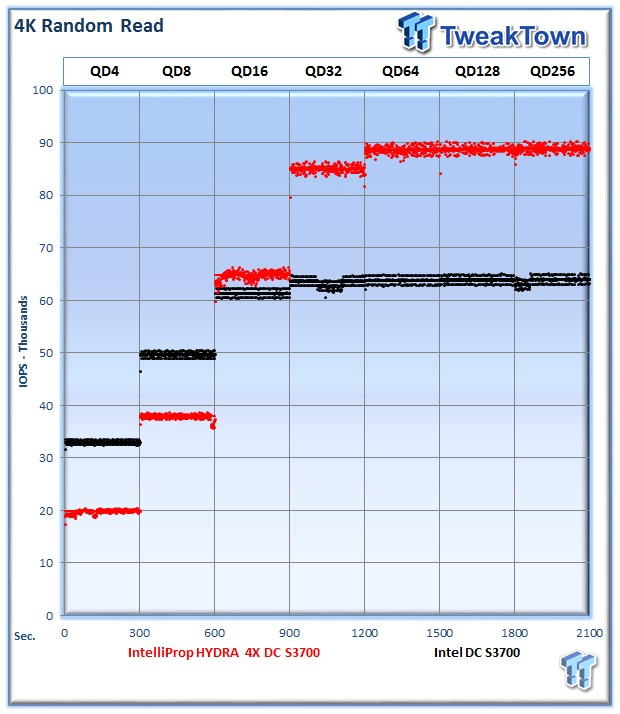
Each QD tested includes 300 data points (five minutes of one second reports) to illustrate performance variability. The line for each QD represents the average speed reported during the five-minute interval.
4K random speed measurements are an important metric when comparing drive performance, as the hardest type of file access for any storage solution to master is small-file random. One of the most sought-after performance specifications, 4K random performance, is a heavily marketed figure.
The HYDRA Bridge averages 88,917 IOPS with a 4K random read workload at QD256. The single Intel DC S3700 averages an impressive 63,870 IOPS. Even though the most impressive gains are found in random write/mixed workloads, there is a big benefit to read-centric workloads as well.
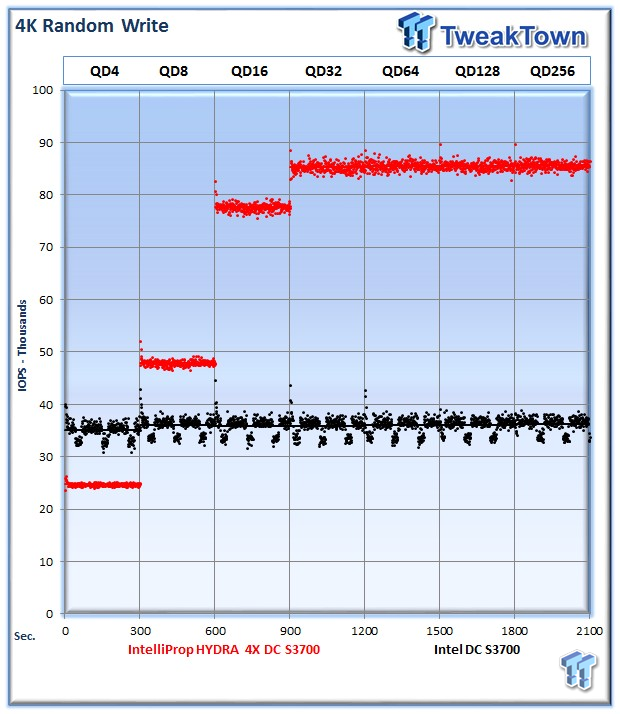
Garbage collection routines are more pronounced in heavy write workloads; this leads to more variability in performance.
The HYDRA really shines in this test, with a blistering average of 85,664 IOPS at QD256. The single DC S3700 performs admirably with an average of 36,228 IOPS. In IntelliProp's internal testing, they have reached 90,000 IOPS.
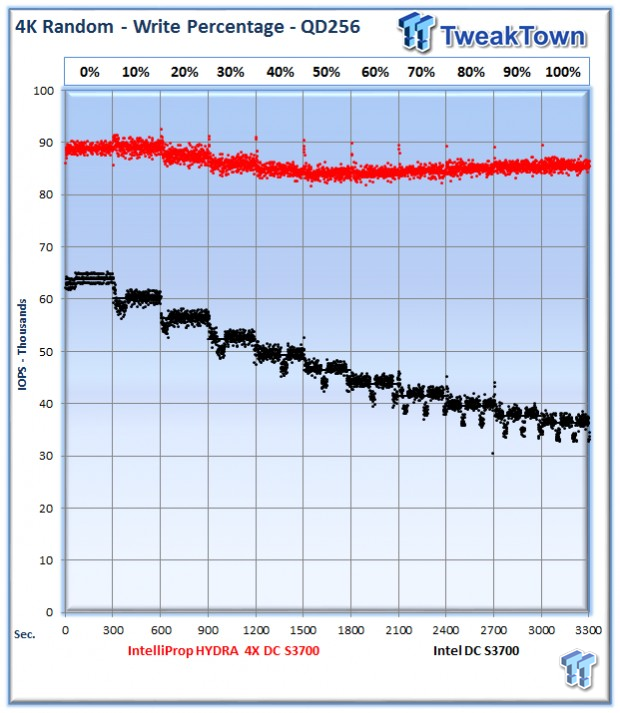
Our write percentage testing illustrates the varying performance of each solution with mixed workloads. The 100% column to the right is a pure write workload of the 4K file size, and 0% represents a pure 4K read workload.
Another major benefit to the HYDRA Bridge solution is the resilience to varying workloads with mixed read/write data. While the single Intel DC S3700 exhibits the typical performance plot as we mix in write data, the four Intel's aggregated on the HYDRA barely blink at the heavier workloads.
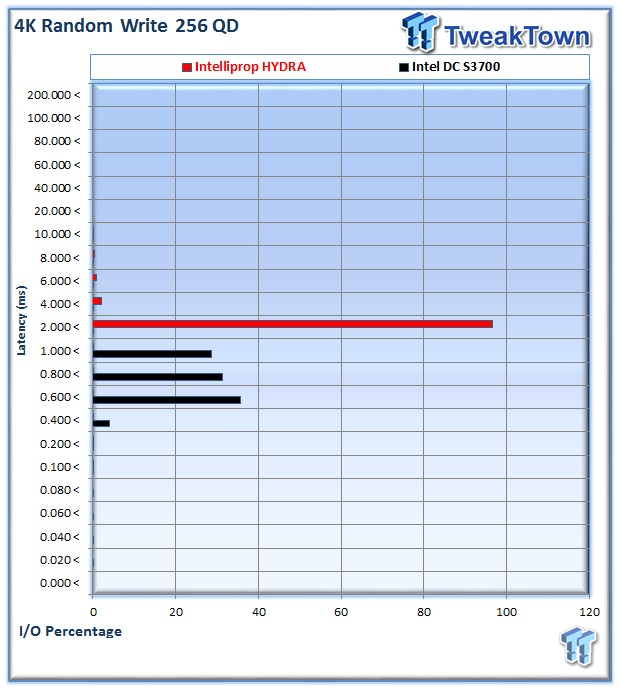
A single Intel provides lower latency than the HYDRA, with four of the drives aggregated, but the increased latency falls into an acceptable range, which is comparable with other RAID solutions.
8K Random Read/Write
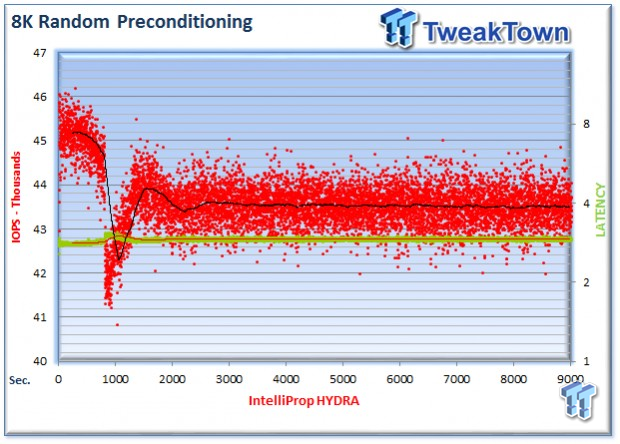
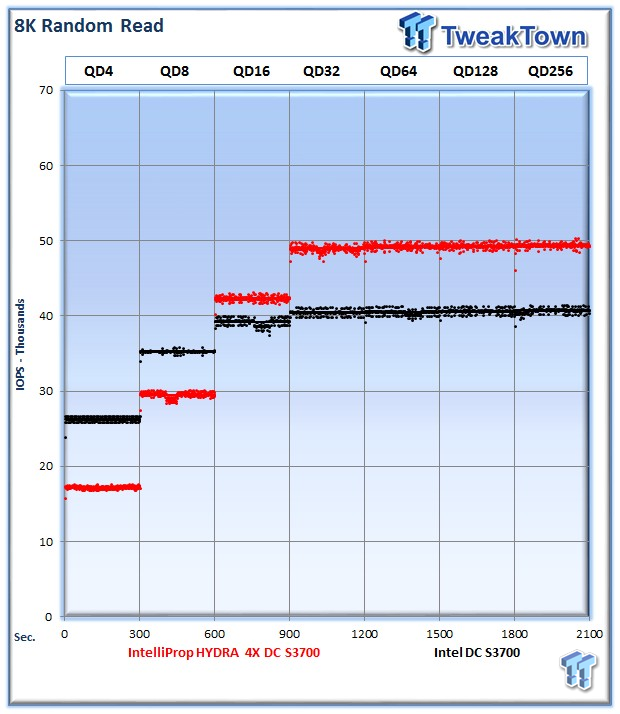
8K random read and write speed is a metric that is not tested for consumer use, but for enterprise environments, this is an important aspect of performance. With several different workloads relying heavily upon 8K performance, we include this as a standard with each evaluation. Many of our Server Emulations below will also test 8K performance with various mixed read/write workloads.
The average 8K random read speed of the HYDRA is 49,415 IOPS at QD256, in comparison to the single Intel DC S3700 at 40,715 IOPS.
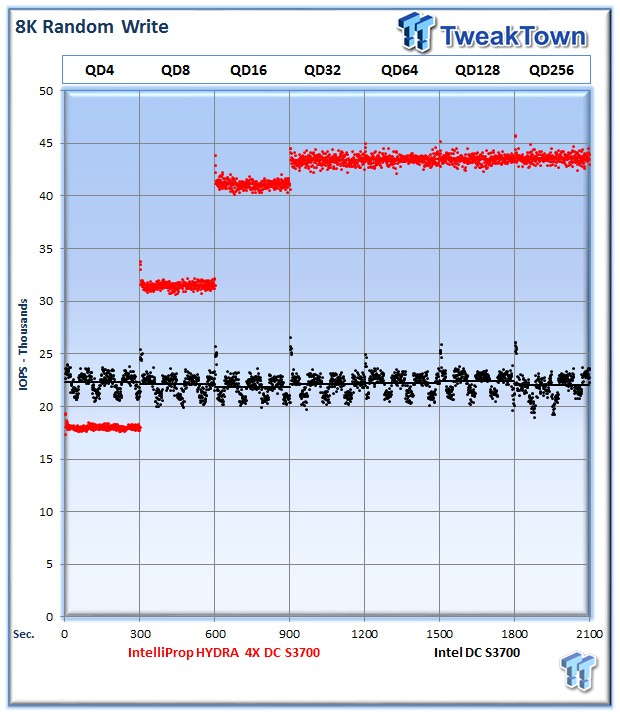
The write performance continues to be stellar, with the HYDRA's IOPS weighing in at a beastly 43,627 at QD256, in comparison to 22,071 from the single SSD.
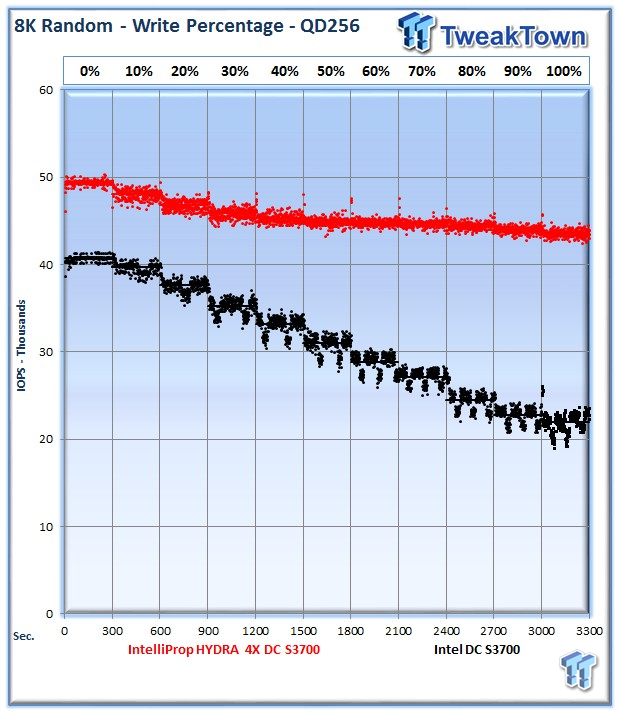
The HYDRA also continues to exhibit excellent resiliency to mixed workloads.
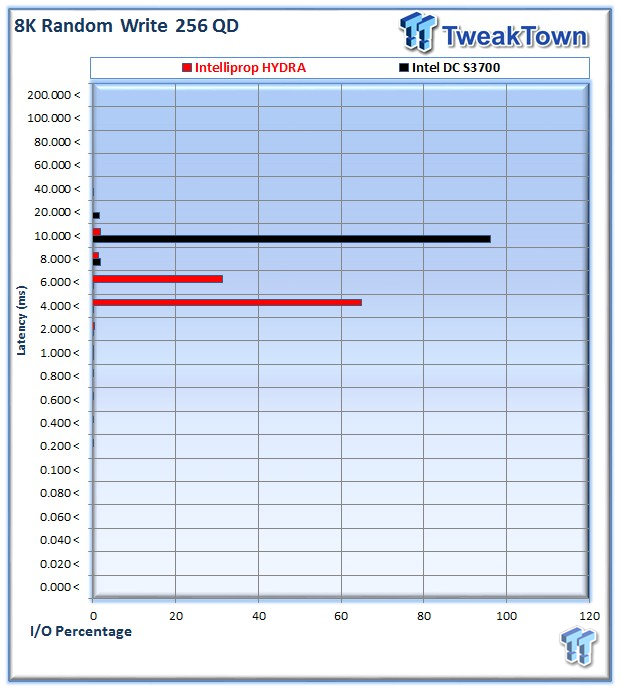
128K Sequential Read/Write
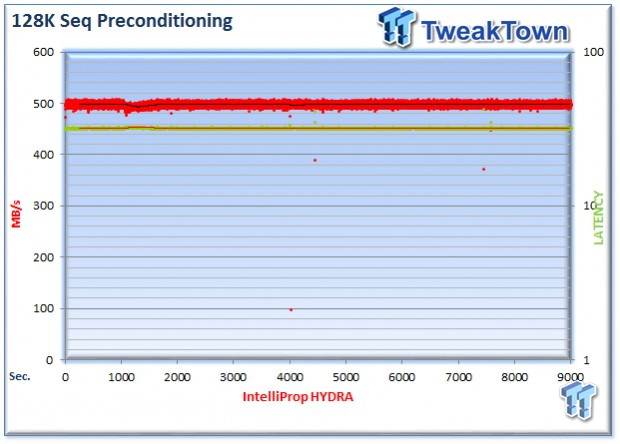
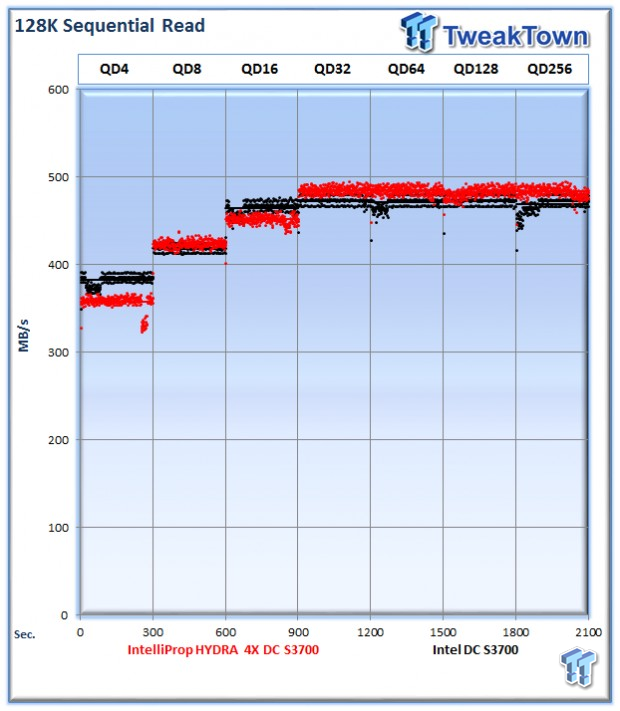
The 128K sequential speeds reflect the maximum sequential throughput of the SSD using a realistic file size encountered in an enterprise scenario.
The HYDRA, with four of the Intel DC S3700s, slightly edges the single DC S3700 with a throughput of 483 MB/s. This is getting close to bumping against the limit of the SATA connection.
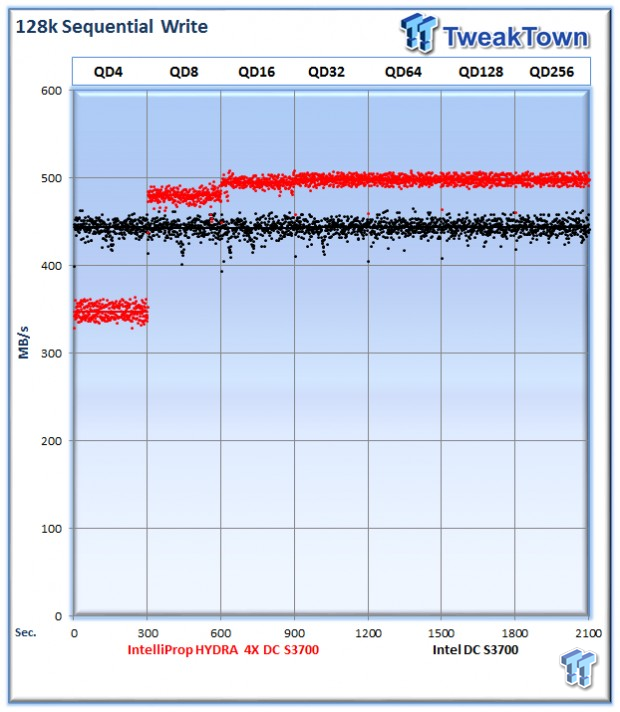
The HYDRA Bridge delivers 498 MB/s of sequential write speed, and the single drive lags behind with 483 MB/s.
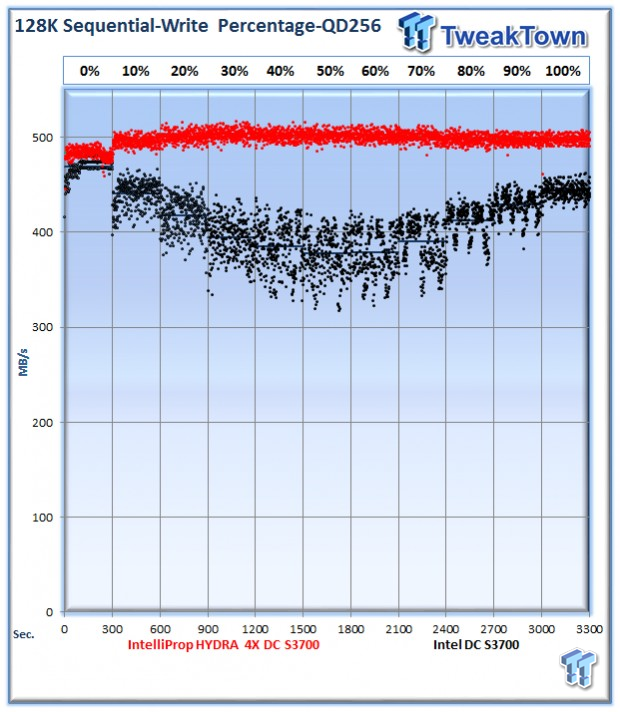
The single Intel DC S3700 does not lag much as we mix in heavier percentages of write activity, but the HYDRA actually speeds up as we move into the harder workloads.
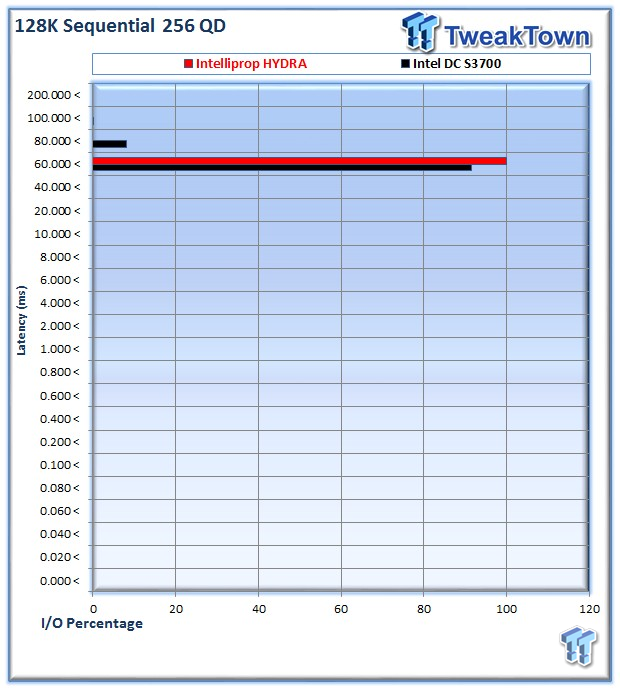
For sequential access, the HYDRA actually delivers lower latency than a single drive; this is quite the feat.
Database/OLTP and Webserver
Database/OLTP
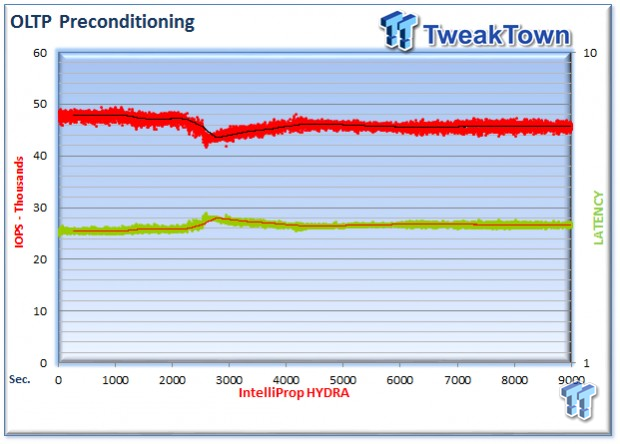
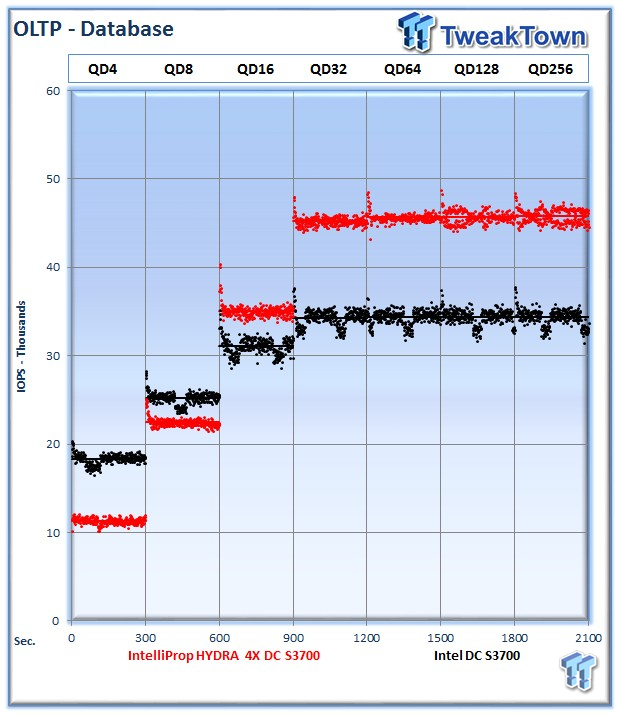
This test emulates Database and On-Line Transaction Processing (OLTP) workloads. OLTP is the processing of transactions such as credit cards and high frequency trading in the financial sector. Enterprise SSDs are uniquely well suited for the financial sector with their low latency and high random workload performance. Databases are the bread and butter of many enterprise deployments. These are demanding 8K random workloads with a 66% read and 33% write distribution that can bring even the highest performing solutions down to earth.
The HYDRA delivers 45,797 IOPS at QD256, in comparison to 34,316 IOPS from a single drive.
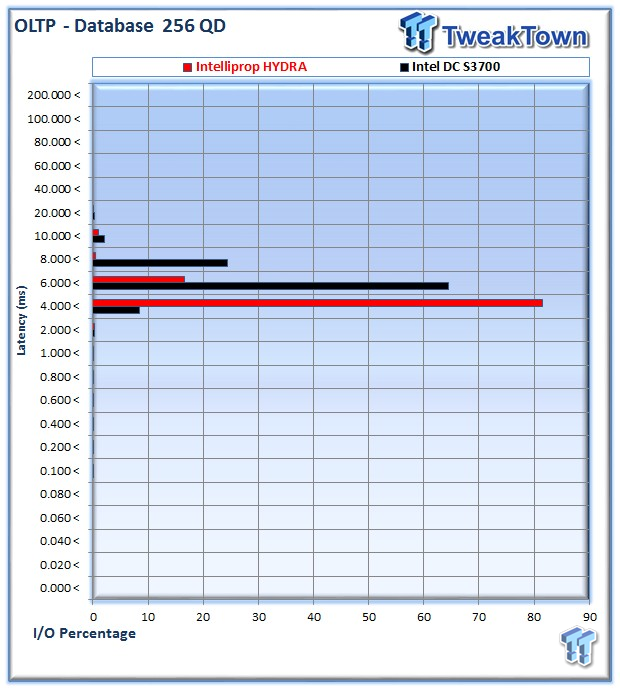
The Hydra once again manages to best the latency of a single drive in this test.
Webserver
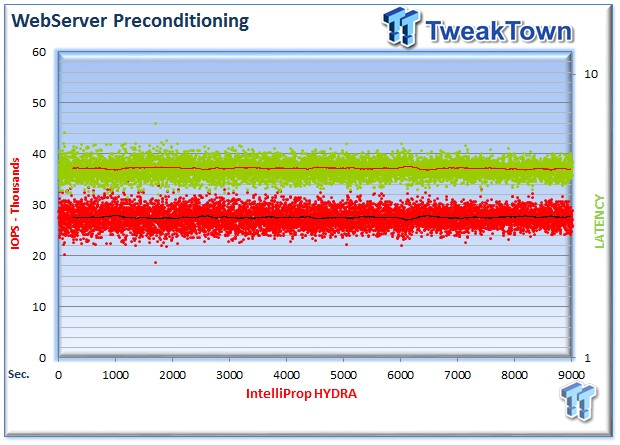
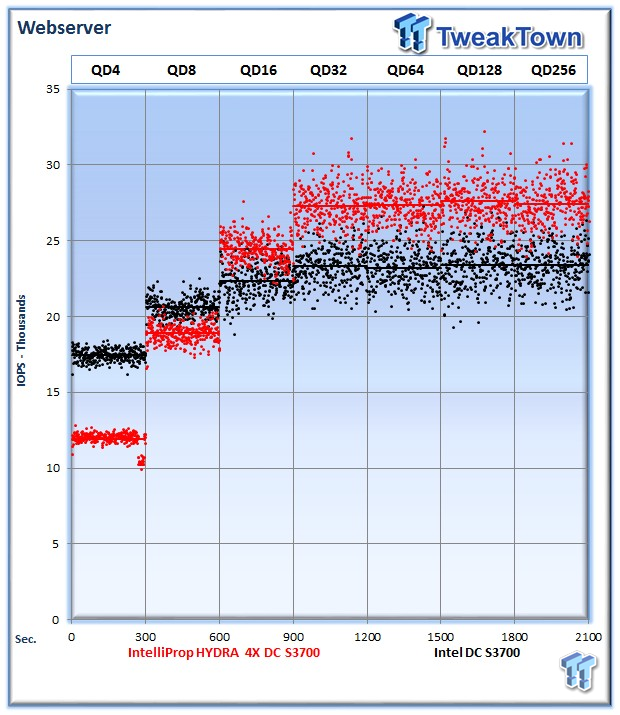
The Webserver profile is a read-only test with a wide range of file sizes. Web servers are responsible for generating content for users to view over the internet, much like the very page you are reading. The speed of the underlying storage system has a massive impact on the speed and responsiveness of the server that is hosting the website, and thus the end-user experience.
The HYDRA averages 27,426 IOPS in this read-centric test, while the single drive provides 23,386 IOPS.
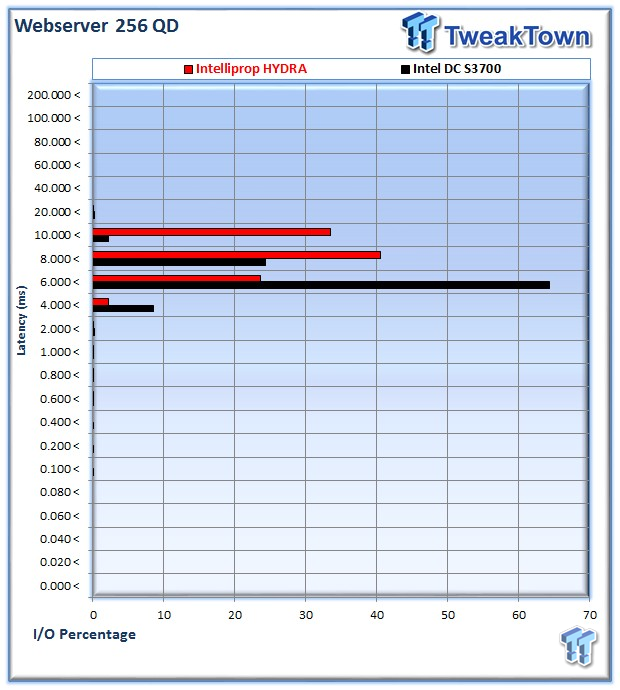
Emailserver
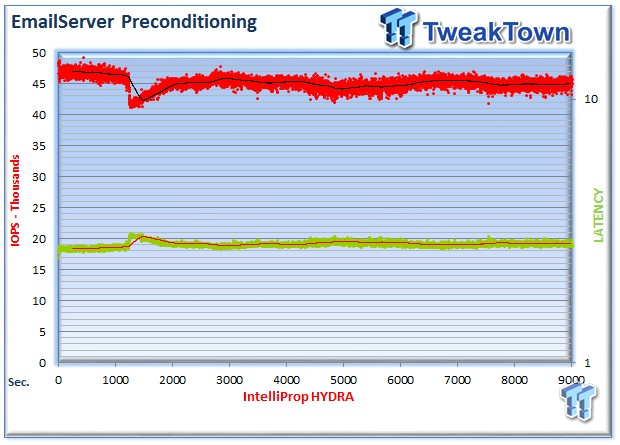
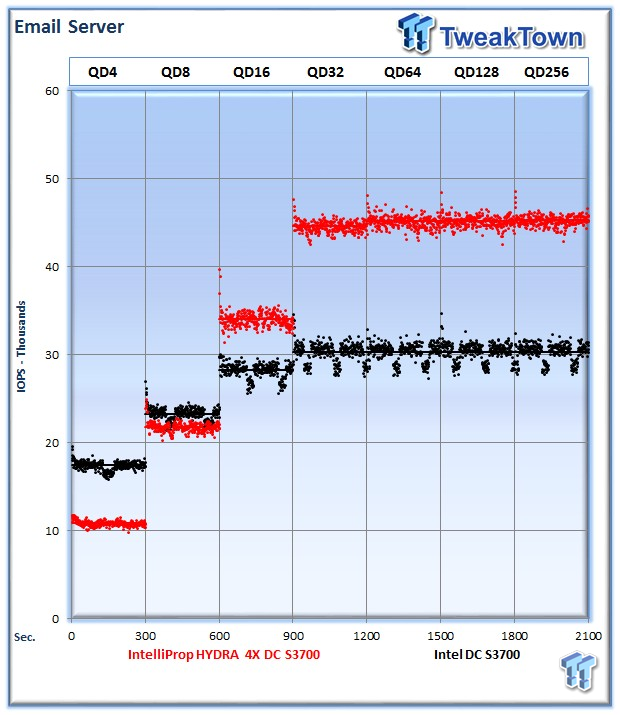
The Emailserver profile is a very demanding 8K test with a 50% read and 50% write distribution. This application is indicative of the performance of the solution in heavy write workloads.
The HYDRA really shines in heavy write workloads, with an average of 45,268 IOPS in this demanding test. The single drive lags far behind at 30,344 IOPS.
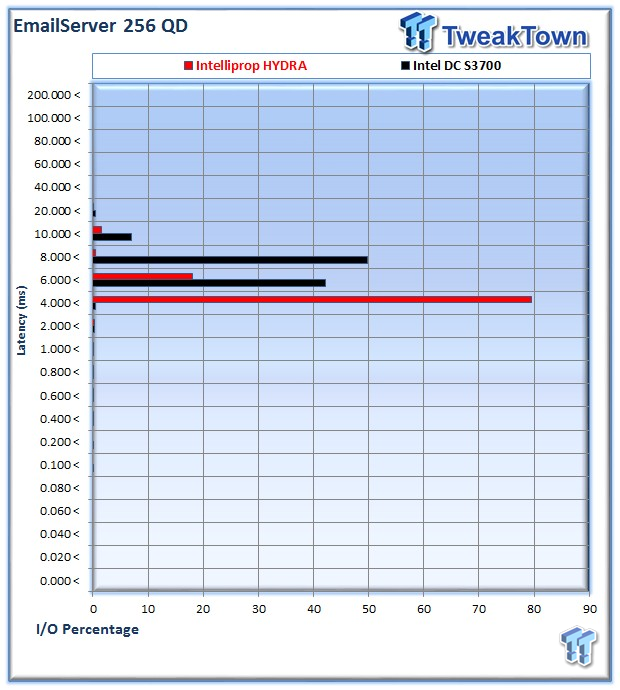
Once again, the HYDRA provides better latency than a single drive in a heavy write workload.
Final Thoughts
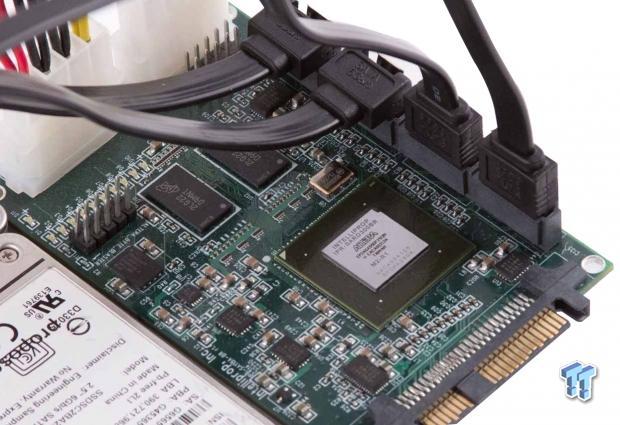
They say necessity is the mother of invention, and the HYDRA Bridge IPA-SA117A-BR is a good example of that in action. Increasingly small system footprints, and financially viable NAND pricing, have created a large demand for powerful performance and increased density.
Packing up to 4TB inside a single SSD allows for HDD capacity in an amazingly small form factor. As more SSD controllers with 2TB capabilities become available, such as the new LSI SF3700, there are further opportunities for enhanced density from solutions such as the HYDRA Bridge. There are already designs in production, most notably by Avant, but many will never be aware of the underlying HYDRA Bridge technology. Avant manufactures devices for several large SSD suppliers, and we expect to see several designs on the market under different branding.
A big benefit of the HYDRA is the increased endurance; the amount of useable endurance per slot is effectively quadrupled. Users who require high capacity and endurance typically utilize multiple drives with RAID controllers and HBA's. This adds design complexity and expense from installation of multiple SSDs and RAID hardware. Cramming the power of four devices into one alleviates the need for these expensive measures.
We measured power consumption of the HYDRA and all four Intel SSDs at 14.8 Watts for sequential write workloads. For random data, it weighed in at 15.9 Watts. It is safe to say that the HYDRA is an efficient controller, and packs quite the punch for such low power consumption.
Ease-of-use is important, and the HYDRA is configured by end-users as a normal volume. There is no way to differentiate a HYDRA-infused solution from any other drive, the system is transparent and requires no special drivers or software. The HYDRA platform is also customizable for integrators if required. The Intel DC S3700 drives we utilized have not been used in a HYDRA setup prior to our testing, so there is a very real possibility of higher performance with drive-specific tuning from IntelliProp. For our purposes, the HYDRA board was simple. We just plugged in the SSDs and the system required no intervention.
Our test results were amazing for a single-slot solution. We were able to crush single drive results in our tests. The performance with mixed read/write workloads was spectacular, and there was very little performance degradation with heavier write workloads.
In pure write workloads, the HYDRA delivered an astounding 85,664 IOPS in steady state. The use of four drives together essentially alleviated the performance degradation of a single drive as it transitions to steady state. Latency performance was within expectations, with some additional latency incurred in some situations. In heavy write workloads, such as sequential writing, OLTP, and Email workloads, the HYDRA actually delivered lower latency than a single drive.
There are applications for both client and enterprise usage for HYDRA solutions, and we feel it will be well received in the market. For its outstanding performance in steady state, we give the HYDRA Bridge the TweakTown Performance Award.

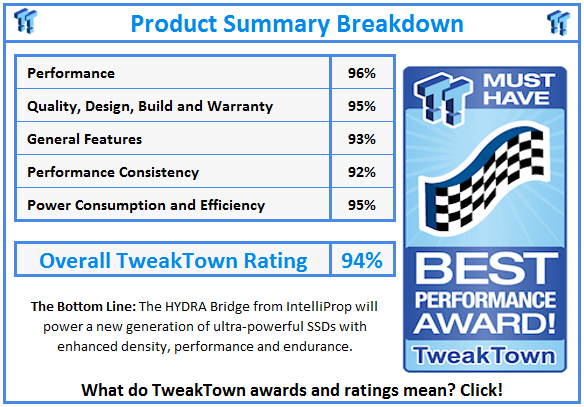
 United
States: Find other tech and computer products like this
over at
United
States: Find other tech and computer products like this
over at  United
Kingdom: Find other tech and computer products like this
over at
United
Kingdom: Find other tech and computer products like this
over at  Australia:
Find other tech and computer products like this over at
Australia:
Find other tech and computer products like this over at  Canada:
Find other tech and computer products like this over at
Canada:
Find other tech and computer products like this over at  Deutschland:
Finde andere Technik- und Computerprodukte wie dieses auf
Deutschland:
Finde andere Technik- und Computerprodukte wie dieses auf